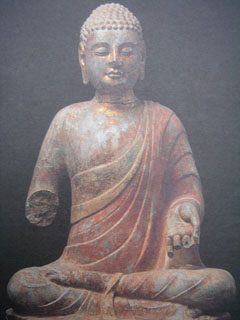This week’s picture shows a seated Buddha carved from grey limestone during the third quarter of the sixth century by an unknown artist working in the province of Shandong, in eastern China. The sculpture is part of a remarkable hoard of about 400 stone Buddhas and Boddhisatvas (enlightened mediators working for universal salvation) discovered in October 1996 during the course of works to level the playing fields of the Shefan Primary School, in the city of Qingzhou. Together with 34 of the hundreds of sculptures found alongside it, this ineffably peaceful and meditative figure can currently be seen at the Royal Academy of Art in London, where a new exhibition entitled “Return of the Buddha” opened just a couple of days ago.
During the last decade, accelerating urbanisation across China has resulted in many significant finds of ancient art and architecture. Buddhist cave-temple complexes on the Silk Road have also been explored with renewed energy by scholars. A recent survey of the field goes so far as to dub this “the Golden Age of Chinese archaeology”. As well as rescuing an incomparably large cache of sixth-century Chinese Buddhist sculpture, the Qingzhou find also confirmed the site on which the once celebrated Longxing Temple – razed in the mid-fourteenth century – formerly stood. The eleventh-century scholar Xia Song gives a tantalising description of it: “The grounds fall steeply to the hollow at the banks of the Yang River. The buildings soar, as if they were floating above double walls.” Nowadays all that remains, visible only in aerial photographs, is the faintest outline of the temple’s foundations beneath a patch of green where children play. Buddhists are taught to expect the disappearance of their own faith’s monumental structures. “All things are impermanent,” the Buddha said in his last injunction to his disciples....


